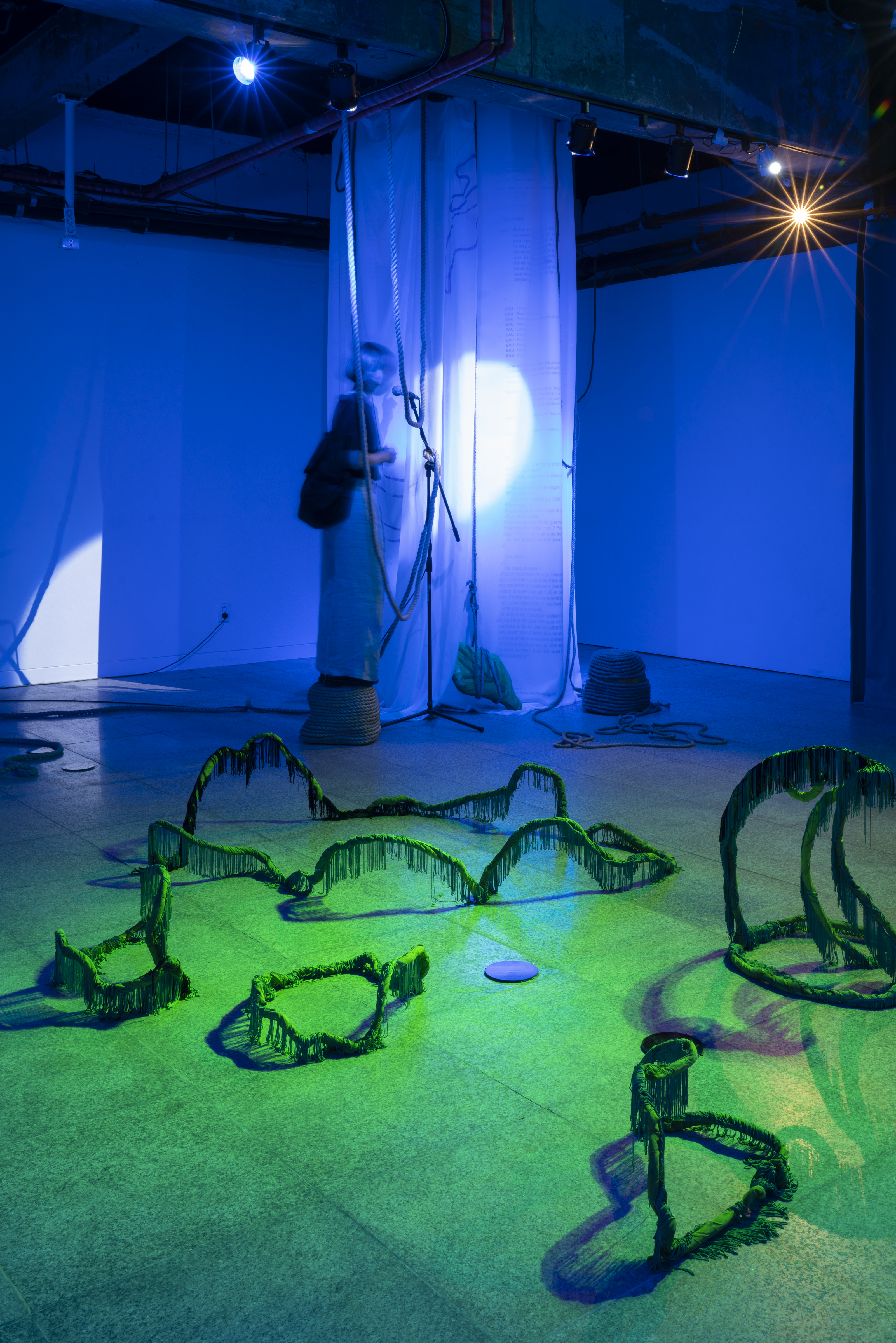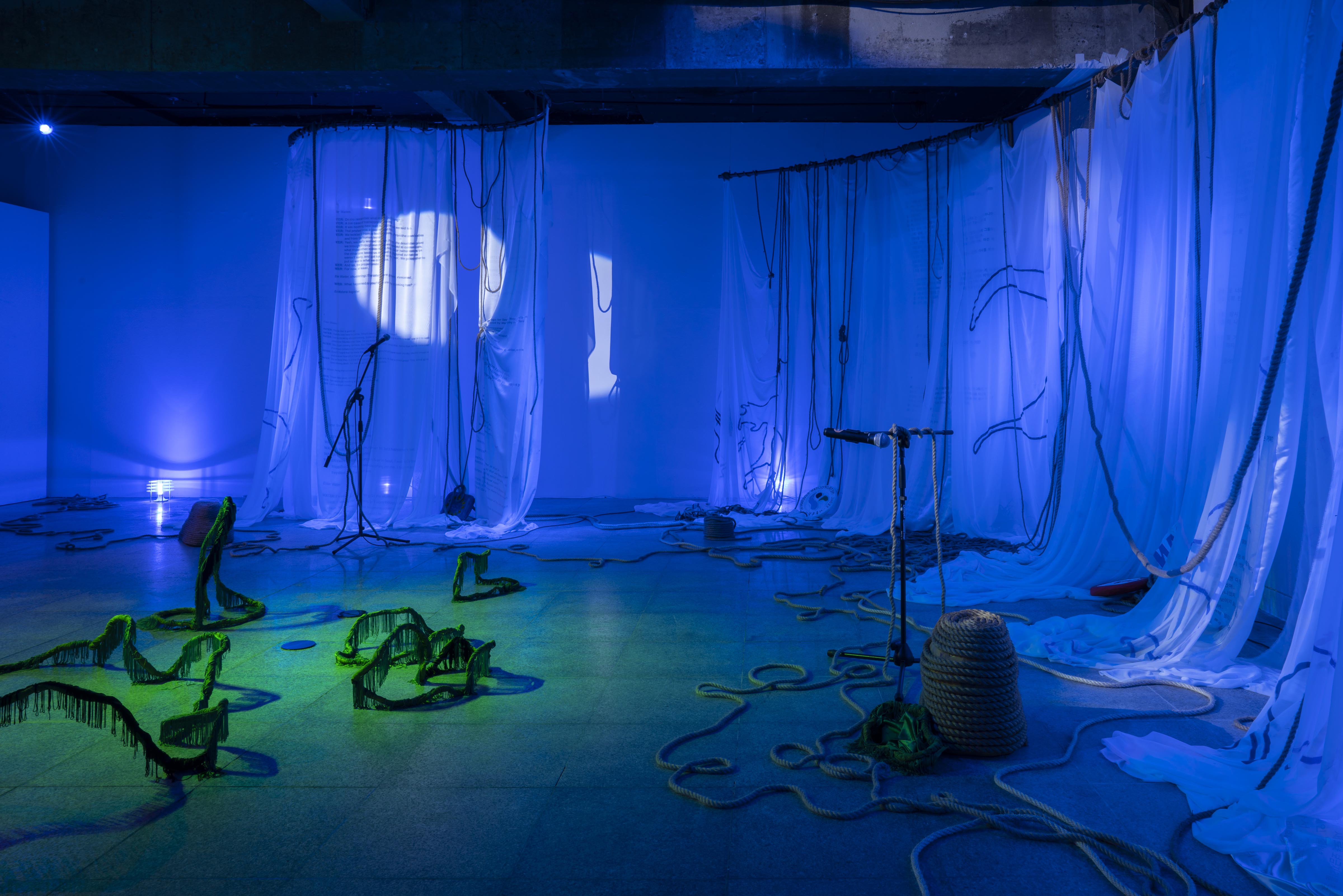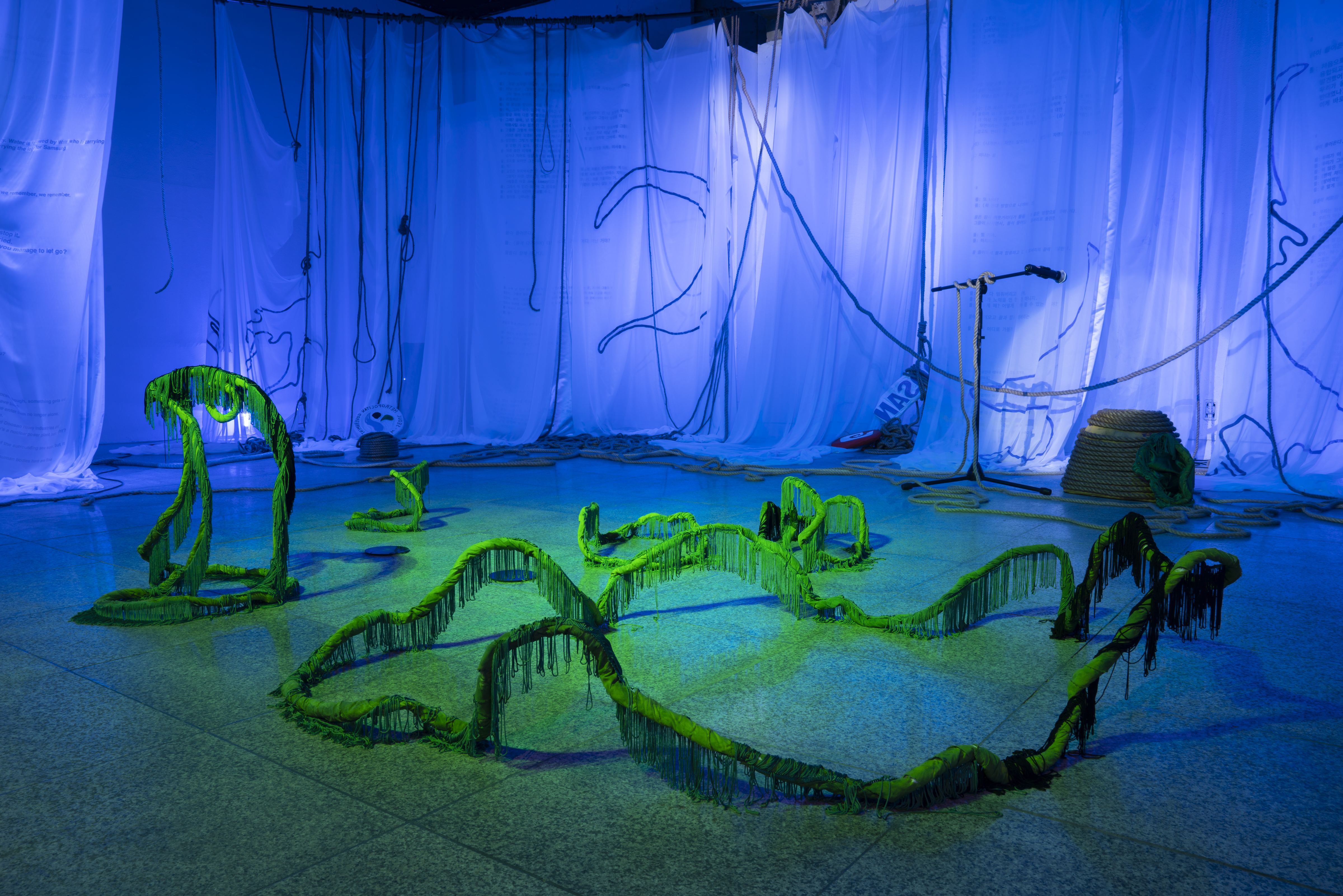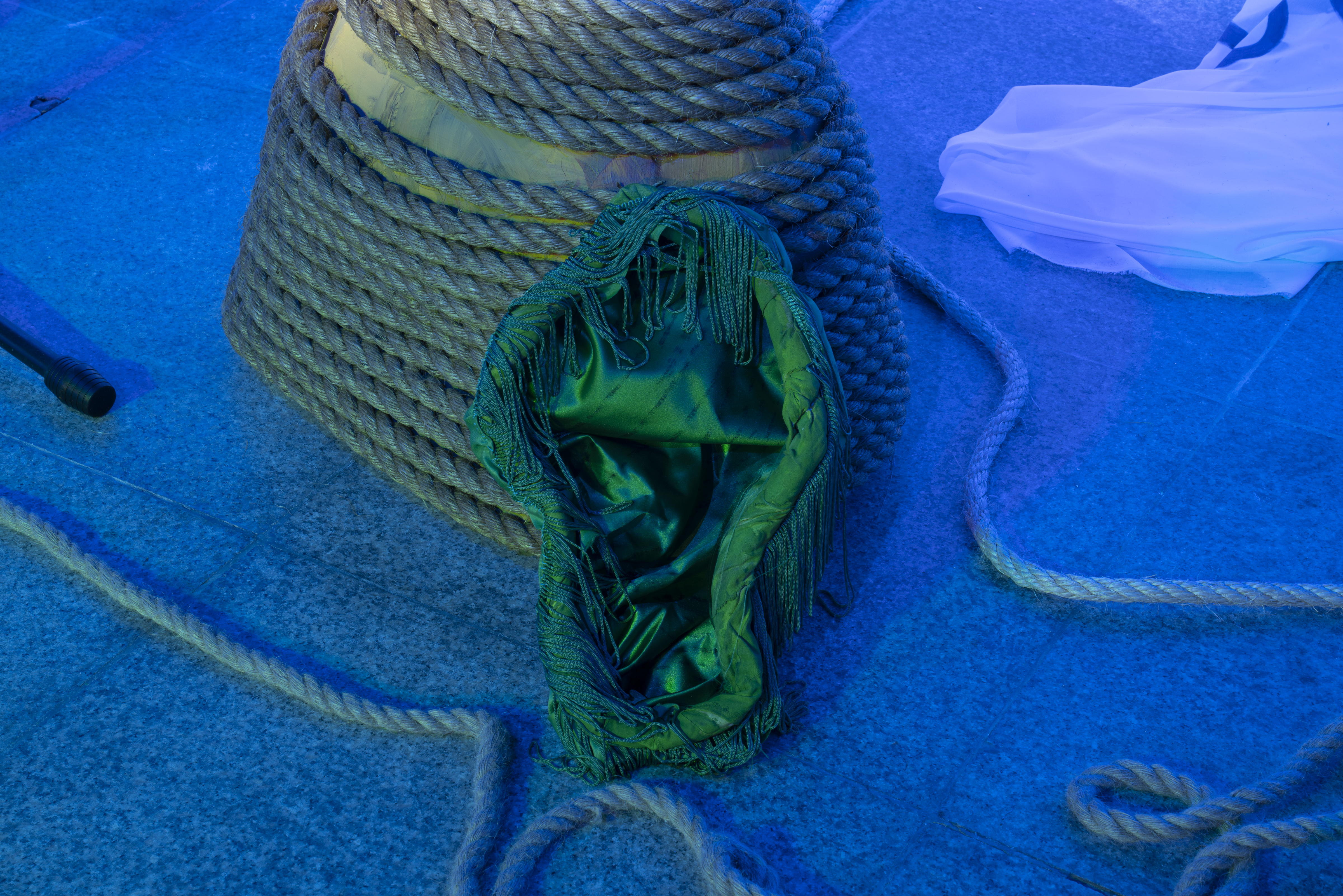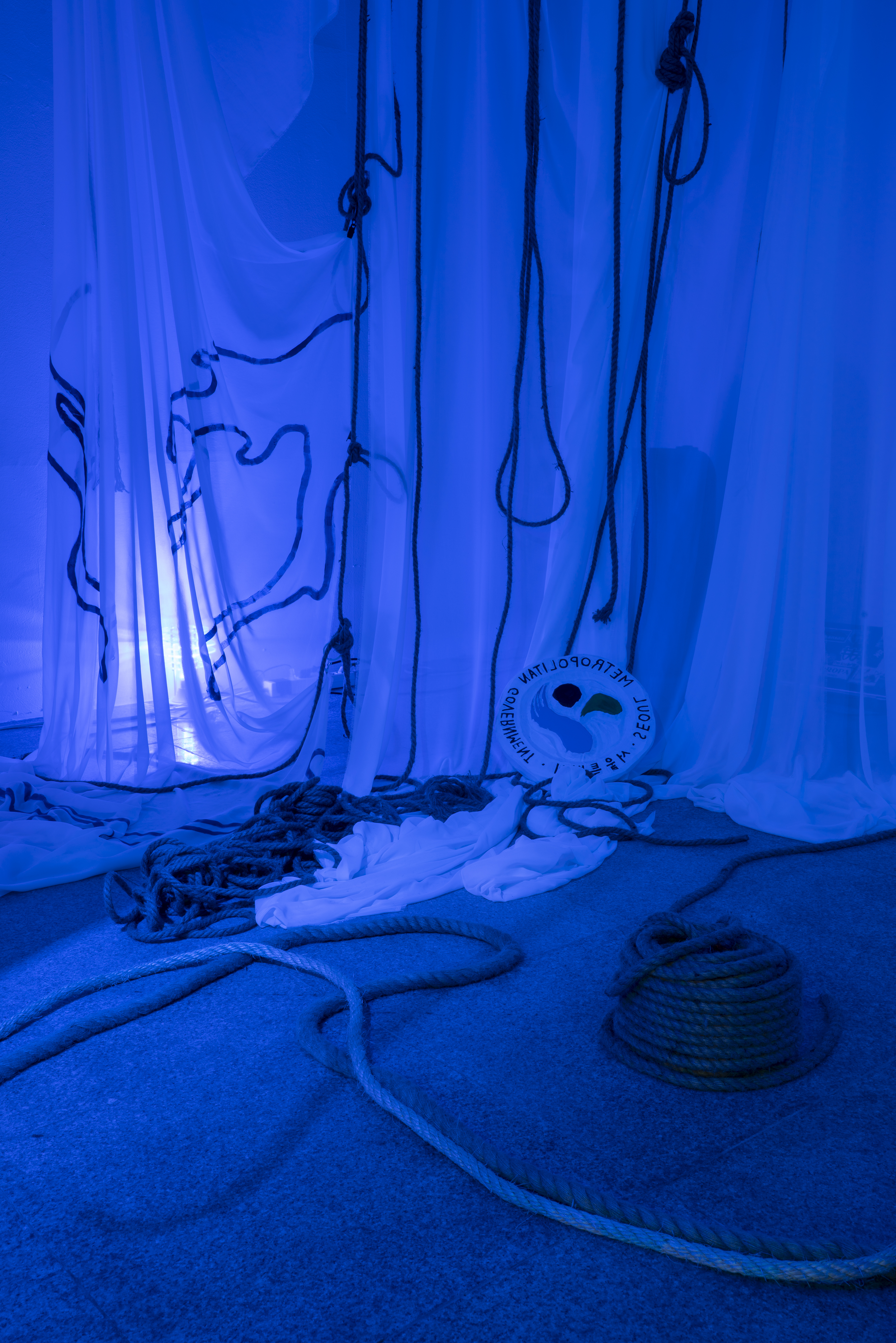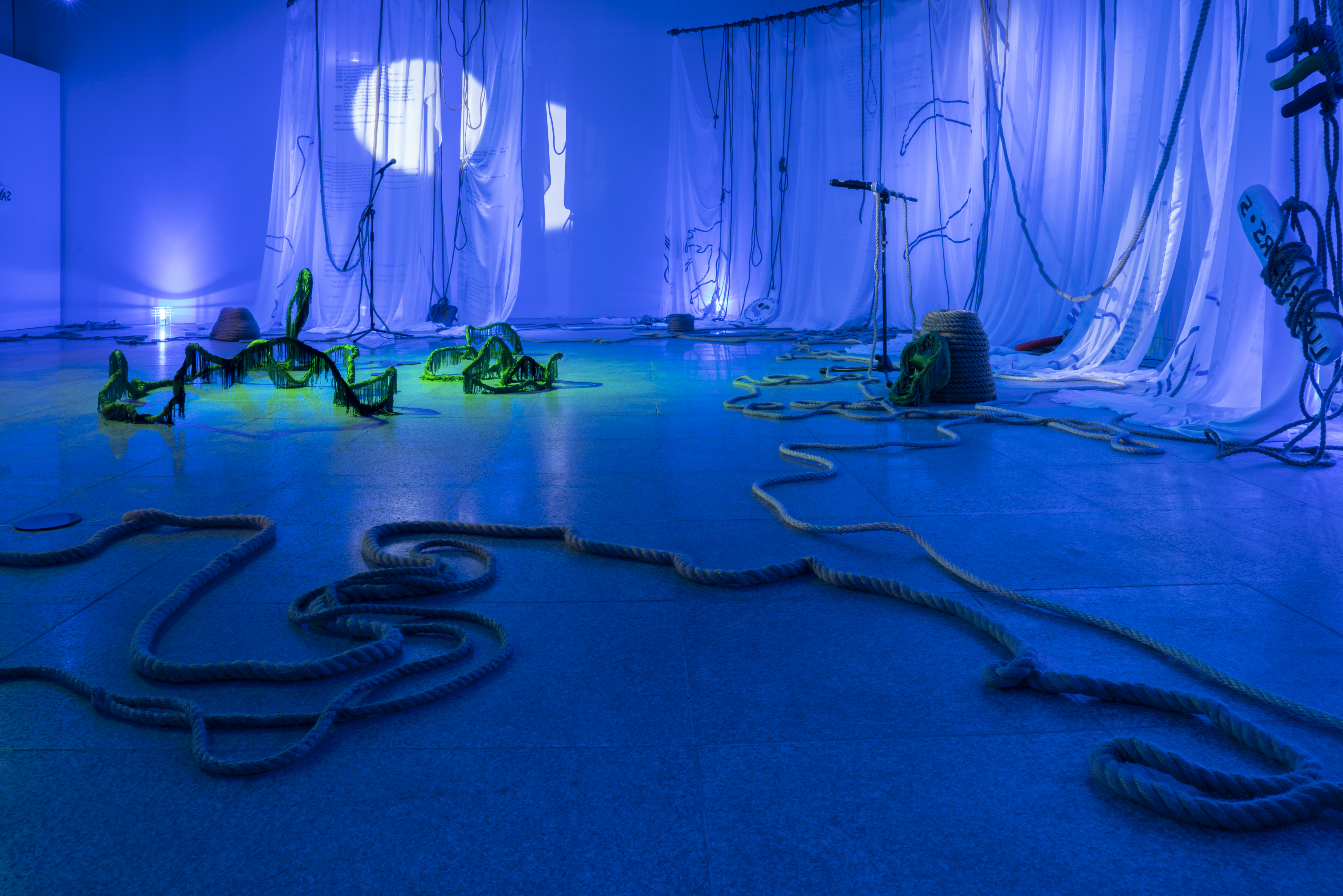<Ecotone: Capacity for Escape> (2022)

Ru Kim, a Conjugation of Escape and Contact
Exhibition Text / Translation by Jieon Lee
A solo show of Ru Kim (b. 1995, Hamburg, Germany), Ecotone: Capacity for Escape (2022), at Post Territory Ujeongguk becomes a conjugation of the bond of their past artworks and practices. Ecotone, a crucial part thereof and simultaneously a focal point in the exhibition present the zone of transition where two different biological communities meet and integrate. It lies down with / moves parallel with Hydrofeminism mainly featured by Astrida Neimanis, author of <Bodies of Water(2017)> and interlocuter of “We Are All at Sea(Talk at the 2nd Riga International Biennial of Contemporary Art)”, as the extension idea from these resources “staying in the same bodies of water together”.
Ru Kim utilises terrestrial thinking as a welcoming gesture to all visitors.
The conversation between ‘Waters’ adopts the ways of scenario to scope out contemporary phenomena and historic incidents. It extends from individual cities to continents and connects each other by looking up with terrestrial and hyperhistorical eyes. Ru Kim appears on the stage and brings their past works, shown in the Mediterranea 19 Young Artists Biennale, Artist Residency TEMI, Sea Art Festival 2021 and Anozero ‘21-‘22—Coimbra Biennial of Contemporary Art, together with newly developed contexts and formations. ‘Water’ at the Kori Nuclear Power Plant, ‘Water’ flowing at the Han River under the Mapo Bridge, ‘Water’ from the Mediterranean Sea and ‘Water’ meeting with lithium. Varied Waters eventually flow as one and the one makes a hydrologic cycle. The one is a ‘contact’ of time and territory and acts as an ‘escape’.
Installation across the stage is rooted in the existence of the ‘serpent’ referred to in <Borderlands: La Frontera(1987)>, which is Chicana feminist literature. The author Gloria Anzaldúa was told by her mother in Mexico when she was young to “avoid snakes.” Snakes have formed phallic symbols such as ‘being unable to keep women’s chastity’, ‘being dangerous when bitten,’ as well as ‘having poison’ and ‘having the ability to interpermeate’, and are perceived as threats. Anzaldúa drank the blood of a dead rattlesnake. That night, she dreamt that she looked at the world through the serpent’s eyes. A young Chicana’s eyes and serpent’s eyes and our eyes on the stage haven’t shared life, but we see the multifaceted events of the past and the present together. The word ‘serpent’ in Korean, ‘뱀’, a homonym for interpermeation, makes the same sound together and the stage-exhibition hall becomes an ecotone. Two differently rooted feminist theories(communities) are woven into one chapter with ‘caring’ and ‘solidarity’ bringing about the ongoing events and situations. The remnants of the events and situations are brought together and stopped for a moment to become artworks.
Ru Kim has done(practised) art. ‘Doing artist’ rather than ‘being an artist’ can be seen in the form of work that changes severely and in the behaviour of constantly initiating. Their practices escape from repeating, overlaying, trimming and training and focus on the volatility, shadow and remainders of voices and gestures. Is it what is left over or what has sprouted? Sculptural shell-flesh-snake costumes contact the head-body-tail body. Through contact, the bodies and costumes become bodies of water by contorting, suffocating, supporting each other, clumping, and dispersing. The head speaks, questions, and responds. The body follows the tail. The tail embraces the body. Wandering, entanglements, voices, conflicts and moves occur in one body. The microphones installed in the stage-exhibition hall call to words as a trigger for someone’s ‘voice.’ Responding words resonate and overlapping sounds take back the soliloquy.
What could ‘escape’ be for Ru Kim? Getting away from a certain state, encountering a transition in the getaway. A journey of a serpent from land to water and from shallow water to the deep sea. A journey of escape is a contact to the new world, and this contact circulates as a result of escape.
We escape through contact. We contact through escape.
-
<에코톤: 탈출 역량> (2022)
루킴, 탈출과 접촉의 컨쥬게이션
글. 이지언
루킴 (1995, 함부르크 독일 출생) 의 개인전 <에코톤: 탈출 역량 Ecotone: Capacity for Escape(2022)>은 그의 지난 작품들 사이의 상호작용을 보여주는 컨쥬게이션이 된다. 타이틀의 일부이자 작가의 주된 관심사인 “에코톤 Ecotone”은 두 개의 다른 생물학적 커뮤니티가 만나 전환을 꾀하는 영역으로, <하이드로페미니즘 Hydrofeminism(2017)>에 대한 주요 저자 아스트리다 네이마니스 Astrida Neimanis의 대담 “우리는 모두 바다에 있다 We Are All at Sea”에서 언급된 ‘함께 같은 수역에 머무름’의 연장선에 놓인다. 작가는 네이마니스의 지구적 사고 Terrestrial Thinking를 환대의 제스처로 활용한다.
물들의 대화는 시나리오 형식을 차용하여 동시대 물에서 일어나는 현상, 역사적인 사건, 개별적인 도시에서 대륙으로 확장시키며 전지구적-초역사적인 시선으로 서로를 잇는다. 작가는 메디테라네아 19회 젊은 예술인 비엔날레, 대전테미예술창작센터, 2021바다미술제, 아노제로 ‘21-’22 코임브라 현대미술비엔날레의 작업 내용들과 함께 새로운 컨텍스트와 형태로 무대에 등장한다. 고리 원전의 ‘물’과 한강 마포대교 아래의 ‘물’, 지중해의 ‘물’과 리튬을 만나는 ‘물’. 서로 다른 물들은 결국엔 하나로 흐르고, 흐르는 물들은 순환한다. 하나로 흐르는 물들은 시간과 영역의 ‘접촉’이며 ‘탈출’의 몫으로 작용한다.
무대를 가로지르는 설치는 치카노 페미니즘 저술서 <Borderlands: La Frontera(1987)>의 ‘뱀’의 존재에서 출발한다. 저자 글로리아 안살두아는 어릴 적 멕시코에서 어머니에게 ‘뱀이 있는 곳을 피하라’는 말을 들어왔다. 뱀은 ‘여성의 정조를 지키지 못하게 되는 것’, ‘물리면 위험해지는 것’이라는 남근상징Phallic Symbol을 형성해왔고, ‘독을 지니고 있는 것’, ‘그것을 침투시키는 능력을 가진 것’으로 위협적인 존재로 인식된다. 글로리아는 죽은 방울뱀의 피를 마시게 된다. 그날 밤 뱀의 눈으로 세상을 보는 꿈을 꾼다. 어린 치카나의 눈과 뱀의 눈, 이곳을 찾은 우리의 눈은 같은 삶을 공유하지는 않지만 과거와 현재의 다면화된 사건들을 함께 목도한다. ‘뱀’과 ‘뱀(배어남)’은 같은 소리를 내며 무대-전시장은 에코톤이 된다. 서로 다른 루트의 페미니즘(커뮤니티)은 ‘돌봄’과 ‘연대’로 하나의 장으로 엮이며, 엮임으로 발화하는 현상들을 데려온다. 데려온 현상의 잔재는 잠깐 멈추어 작품이 된다.
루킴은 작가를 (실천)해왔다. 작가가 ‘됨’이 아니라 ‘함’은 지독하게 변하는 작업의 형태와 끊임없이 말을 거는 행동에서 볼 수 있다. 그의 실천Practice은 깎아냄, 덧바름의 반복과 연습에서 탈출해, 목소리와 몸짓의 휘발성과 그림자, 남겨짐에 집중한다. 남겨짐인가 혹은 돋아남인가. 조각스러운 패총-살-뱀 코스튬은 머리-몸통-꼬리 몸과 접촉한다. 접촉으로 인해 몸과 코스튬은 가변적인 존재가 되어 서로를 일그러뜨리고 옥죄고 지지하며 뭉치고 흩어진다. 머리는 말한다. 묻고 대답한다. 몸통은 꼬리를 이끈다. 꼬리는 몸통을 감싼다. 모든 배회, 얽힘, 목소리, 갈등, 움직임은 하나의 몸에서 발생한다는 것이다. 무대-전시장에 설치된 마이크는 누군가의 ‘목소리’를 트리거로 단어들을 불러온다. 반응하는 단어들은 함께 소리를 내고 겹치는 말들은 혼잣말을 거두어간다.
작가가 말하는 탈출이란 무엇일까. 어떤 상태로부터의 벗어남, 벗어나므로 만나는 변화. 뱀이 땅에서 물속으로, 얕은 물에서 심해로 가기까지의 여정. 탈출의 여정은 새로운 세계로의 접촉이며, 접촉은 탈출의 결과로 순환한다.
우리는 접촉을 통해서 탈출한다. 우리는 탈출을 통해서 접촉한다.

Interpermeations
Sound, audio programming, microphones, text, digital printing on fabric, acrylic on fabric, acrylic on sculpted XPS, mixed media costume sculpture, Manila rope
Variable dimensions
2022 (Post Territory Ujeongguk, Photos by 양승욱 Seungwook Yang)
Performers: Chai Eun Shin, Nicolas Julian Brahim, Ru Kim
Music (Live Performance): And Rose Peacock
Design: Minchai Lee Installation
Installation Assistance and Lighting: Hye Jeong Kim
Audio Programming: Artur Pispalhas
Grant Support: City of Seoul, Seoul Foundation for Arts and Culture
Cooperation: Post Territory Ujeongguk



